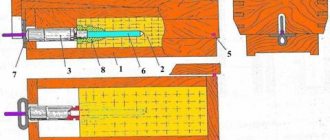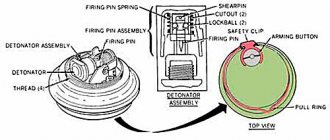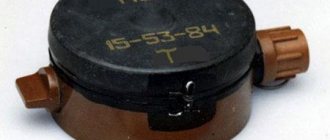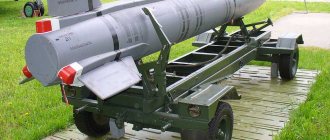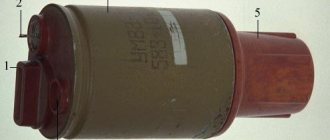What kind of product was this?
Developed back in the late 50s, the device was recommended for use by a variety of “special forces” such as the “Green Berets” and Marines, and therefore was not particularly shown in public. And it’s not just about maintaining secrecy, but also about ensuring the safety of your own soldiers.
It turned out to be a very dangerous thing - simple infantry could blow itself up.
On the same topic
Explosive “zoo” of World War II: mines made of glass and paper
The experience of the Second World War and the Korean War showed that anti-personnel fragmentation mines of all parties involved in the conflicts have a number of disadvantages.
Firstly, the massive metal (usually cast iron) body, which produced a large number of fragments, was heavy. Secondly, it, as a rule, fragmented heterogeneously: some fragments were too heavy, flew close and did not have time to gain the required speed, and some were too small and could not cause serious damage. Even the use of a notch applied to it did not help. Thirdly, the fragments flew not only at the enemy, but in all directions, so the efficiency of such engineered ammunition was, to put it mildly, low.
There were also technological problems: casting a cast iron body required serious, energy-intensive melting equipment, and the use of TNT (pressed or cast) was also not the best solution. A new mine was needed: light, reliable, technologically advanced and, again, with high efficiency.
What happened? The flat, slightly curved (for better scattering of fragments) body was made of newfangled plastic (polystyrene reinforced with fiberglass acts as such). This is just a box for the contents: it, of course, does not produce fragments; when it explodes, it smashes into dust. But inside...
The promising explosive C4 was used as an explosive - hexogen mixed with a plasticizer. This “dough” is easily formed simply by hand: it is much more convenient than filling a container with fused TNT, and the power is higher - one and a half times. 700 steel balls were used as destructive elements: they were laid out in an even layer and filled with epoxy resin for reliability.
For installation in the ground there were sliding swivel legs, and the kit also included a very useful clamp, with which the product could be secured, for example, to a tree. Oh, yes: since the explosion was directed, a primitive sight was added on top of the body.
You have to at least understand where the balls will fly...
The mine did not have its own fuse, but the nests allowed the use of standard fuses that were in service. Thus, the Claymore could initially be activated, for example, via wires - using a simple blasting machine, from a mechanical pull-action fuse, or from a break sensor.
The name, by the way, was very interesting: a claymore is one of the varieties of the Scottish sword (although the broadsword is also called the same), a characteristic feature of which is a developed guard (crossguard) with arms tilted forward. At their ends were stylized images of a four-leaf clover. It is the arms that diverge forward that resemble the dispersion sector of directed mine fragments.
The spread, by the way, was quite decent: say, the domestic OZM-72 (colloquially - “Witch”), adopted for service in 1973, gave a continuous damage radius of 25 meters with a total weight of five kilos. And the M18A1, with a mass of 1.6 kilos, had a kill zone declared by the manufacturer of up to 100 meters!
Excerpt characterizing MON-90
- I'm an officer. “I would like to see,” said the Russian pleasant and lordly voice. Mavra Kuzminishna unlocked the gate. And a round-faced officer, about eighteen years old, with a face similar to the Rostovs, entered the courtyard. - We left, father. “We deigned to leave at vespers yesterday,” Mavra Kuzmipishna said affectionately. The young officer, standing at the gate, as if hesitant to enter or not to enter, clicked his tongue. “Oh, what a shame!..” he said. - Yesterday I wish... Oh, how sorry!.. Mavra Kuzminishna, meanwhile, carefully and sympathetically examined the familiar features of the Rostov breed in the face of the young man, and the tattered overcoat, and the worn-out boots that he was wearing. - Why did you need a count? – she asked. - Yeah... what to do! - the officer said with annoyance and grabbed the gate, as if intending to leave. He stopped again, undecided. – Do you see? - he suddenly said. “I am a relative of the count, and he has always been very kind to me.” So, you see (he looked at his cloak and boots with a kind and cheerful smile), and he was worn out, and there was no money; so I wanted to ask the count... Mavra Kuzminishna did not let him finish. - You should wait a minute, father. Just a minute,” she said. And as soon as the officer released his hand from the gate, Mavra Kuzminishna turned and with a quick old woman’s step walked into the backyard to her outbuilding. While Mavra Kuzminishna was running to her place, the officer, with his head down and looking at his torn boots, smiling slightly, walked around the yard. “What a pity that I didn’t find my uncle. What a nice old lady! Where did she run? And how can I find out which streets are the closest to catch up with the regiment, which should now approach Rogozhskaya? - the young officer thought at this time. Mavra Kuzminishna, with a frightened and at the same time determined face, carrying a folded checkered handkerchief in her hands, came out from around the corner. Without walking a few steps, she unfolded the handkerchief, took out a white twenty-five-ruble note from it and hastily gave it to the officer. “If their Lordships were at home, it would be known, they would definitely be related, but maybe... now...” Mavra Kuzminishna became shy and confused. But the officer, without refusing and without haste, took the piece of paper and thanked Mavra Kuzminishna. “As if the count were at home,” Mavra Kuzminishna kept saying apologetically. - Christ is with you, father! God bless you,” said Mavra Kuzminishna, bowing and seeing him off. The officer, as if laughing at himself, smiling and shaking his head, ran almost at a trot through the empty streets to catch up with his regiment to the Yauzsky Bridge. And Mavra Kuzminishna stood for a long time with wet eyes in front of the closed gate, thoughtfully shaking her head and feeling an unexpected surge of maternal tenderness and pity for the officer unknown to her. In the unfinished house on Varvarka, below which there was a drinking house, drunken screams and songs were heard. About ten factory workers were sitting on benches near tables in a small dirty room. All of them, drunk, sweaty, with dull eyes, straining and opening their mouths wide, sang some kind of song. They sang separately, with difficulty, with effort, obviously not because they wanted to sing, but only to prove that they were drunk and partying. One of them, a tall, blond fellow in a clear blue scent, stood above them. His face with a thin, straight nose would be beautiful if it were not for his thin, pursed, constantly moving lips and dull, frowning, motionless eyes. He stood over those who were singing, and, apparently imagining something, solemnly and angularly waved his white hand rolled up to the elbow over their heads, the dirty fingers of which he unnaturally tried to spread out. The sleeve of his tunic was constantly falling down, and the fellow diligently rolled it up again with his left hand, as if there was something particularly important in the fact that this white, sinewy, waving arm was certainly bare. In the middle of the song, screams of fighting and blows were heard in the hallway and on the porch. The tall fellow waved his hand.
It's a good thing, you should take it...
As we have already said, third-party wars are a blessing for the military. The mess in Vietnam allowed our gunsmiths to try out the “claymore” in all forms, including testing it in the late 60s at training grounds. True, it turned out that American standards do not really meet the high domestic requirements: at the stated 100 meters, the M18A1 did not provide reliable target coverage - even at 50 meters the probability of destruction was less than 20 percent.
On the same topic
Test: what kind of mine are you?
But in general, the Soviet military really liked the foreign toy - so it was decided to have the same thing in the domestic arsenal under the motto “like theirs - only better.”
In the early 70s, the Soviet Army adopted the MON-50 mine - practically a clone of the Claymore, but with minor differences: ours was 400 grams heavier and ensured more reliable destruction of targets at medium and long distances. The secret lay in the enhanced explosive charge and the shape of the striking elements: instead of “balls”, “rollers” were used, that is, small steel cylinders.
This shape made it possible to fill the body more densely, and the “stump” tumbling in flight caused more severe damage when it hit the target. However, versions with “balls” were also produced: popular rumor says that such a modification was made exclusively “for the KGB special forces.” But, most likely, such differences were dictated by the local technological features of manufacturing plants.
MON-50 could also work with various standard fuses: the simplest tension MUV, the “sentry” VZD-6Ch, electric and electronic MVE series, the Okhota complex, etc.
The belonging to the new engineering ammunition was meticulously reproduced - to the great joy of not only the military, but also civilians. For example, the clamp became an indispensable tool for several generations of Soviet amateur photographers. This device, of course, required a threaded adapter for attaching the camera, but its reliability and brutal appearance more than compensated for this small drawback. Moreover, it was very convenient to use a “corkscrew” to remove wine corks from a bottle...
(Photo: Denis Mokrushin)
All mines must be neutralized
Soviet anti-tank mine TM‑46.
Image: US Military / Wikimedia Commons Humanitarian deminers who clear areas of abandoned munitions after an armed conflict is over do just that. But military demolitionists do not stand on ceremony with mines.
Some structures cannot be opened at all, because they have pressure sensors or other means of protection inside. So, contrary to what we are shown in the movies, in most cases, when demining an area, the devices are simply detonated In‑Situ Landmine Neutralization by Chemical versus Thermal Initiation Deminer Preferences / USA Army with special charges or mine trawls.
In addition, discovered mines are sometimes not touched at all, so as not to attract the attention of the enemy. Otherwise, he can put new “gifts” on top of the already neutralized ones. So they leave the shells and then just mark them on the map. So that the personnel know where to go and where it is better not to go.
An interesting fact: the shores of the Falkland Islands have been strewn with mines for a long time since the 1982 war between Argentina and Great Britain. Because of this, those places became uninhabited and they were populated by Penguins Find Peace in Falklands War Minefields / ENN penguins, which multiplied beyond measure.
The weight of the bird is simply not enough to move the fuse.
The result was spontaneous nature reserves, where, despite the risk, hordes of ecotourists flocked. So Britain rushed to clear the area of mines. And by 2022, the islands had completely cleared Falklands cleared of nearly all landmines, 38 years on from war / The Guardian from shells. The tourists rejoiced. But the penguins were most likely upset. The mines clearly brought them more benefit than trouble.
Works? Let's leave it!
But let's return to combat use. The topic of directional fragmentation mines was of such interest to domestic gunsmiths that after the MON-50 a reinforced version of the MON-90 appeared, and the already in service MON-100 was upgraded to the MON-200 (the latter only has an explosive charge of 12 kilos, and is equipped with nine hundreds of damaging elements).
The first major conflict in which the Soviet armed forces were able to test MONKs was the Afghan campaign. The high efficiency of the new engineered ammunition was noted. MON series mines are still in service virtually unchanged - only the means of explosion are becoming more and more complex. The same process is going on overseas: optical, laser, and seismic sensors are being developed and used for the M18A1.
The American design, which has become a classic, led to the appearance of other versions: Yugoslav MRUD, French MAPED F1, South African Mini MS 803, Chinese, Iranian, etc.
Iranian and Chinese mines
It seems that the class of directed fragmentation mines, which appeared in the middle of the 20th century, will meet its century almost unchanged: except that the designers play around with the brand of explosive and the material of the case. After all, if a thing works well, there is no need to improve it again. Is not it?
Literature[ | ]
- Mine MON-90 // Engineering ammunition. Materials and Application Guide. - M.: Military Publishing House. - Book 6. - pp. 62-68. — 200 s.
- Anti-personnel mine MON-90. User manual. (IE). Military publishing house. Moscow. 1982
- Kolibernov E. S., Kornev V. I., Soskov A. A.
Handbook of an officer of engineering troops / Ed. S. Kh. Aganova. - M.: Voenizdat, 1989. - 432 p. : ill. - BBK 68.516. — ISBN 5-203-00133-2.
| This is a preliminary article about weapons. You can help the project by adding to it. |
All sea mines are round
Most likely, when you hear the phrase “sea mine,” you imagine a round floating metal ball with sticks sticking out in all directions. This is partly true, because the first anti-ship shells were like that.
Disposal of a training naval mine in the US Navy, January 2005. This is what old sea mines looked like. Image: US Navy/Wikimedia Commons
But modern explosive devices look like metal pipes. They lie on the bottom or float in the water column without rising to the surface.
A CAPTOR round is being prepared for loading onto a B‑52 Stratofortress aircraft at Loring Air Force Base, USA. This is what modern sea mines look like. Image: STAFF SGT. RUSS POLLANEN / Wikimedia Commons
As soon as this thing detects a passing ship or submarine that is not responding to a “friend or foe” request, it will fire a homing torpedo towards the intended enemy.

